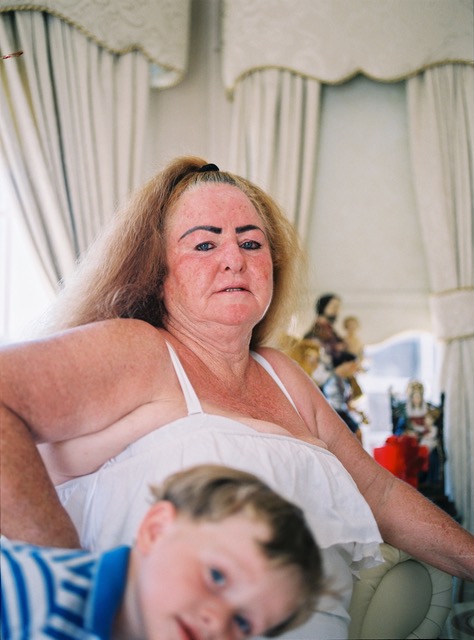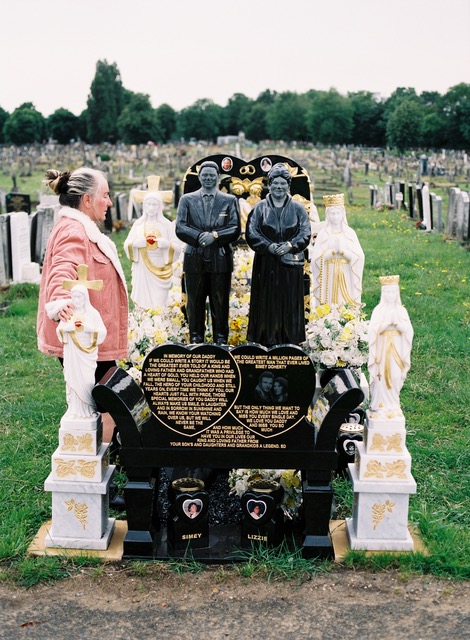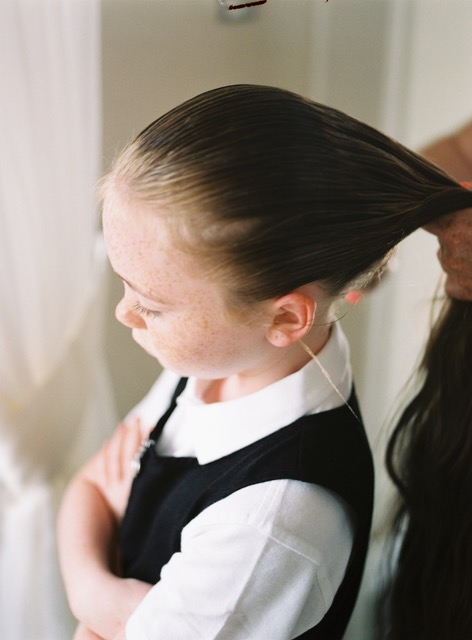Emma Williams started taking photos when she was 16, using an old film camera. The images were mainly of friends, a bit waved, on nights out. She then started using her camera to capture groups she felt were typically underrepresented. Here, she began channeling her favourite photographer, Bruce Davidson, who is known for documenting the civil rights movement in America.By combing her love for photography and documentaries, the idea for a more substantial project formed. After completing an engineering degree in July of 2019, Williams decided to commit a few months to documenting an under-represented ethnic minority: Irish Travellers.
Advertisement
Emma Williams.
"I didn't really know anything about travellers before I started," Williams says, while thumbing through her debut photography book on the community, We Call It Home. The photo book is a selection of photographs from the four months Williams spent with the group of Irish Travellers, at their site on Bashley Road, west London.The book opens with a short introduction from Jane – a member of the community who features in the project: "I am a traveller and I've lived on Bashley Road for 31 years, my whole life," Jane writes. "I feel that it's time to open up to the outside world on how travellers feel about the constant stream of judgement directed towards us."I caught up with Williams at her launch exhibition to find out more about why the book came about, how she gained the community's trust and what she hopes the series will teach people about the travelling community.VICE: Hi Emma, nice photos. Where did the idea for this project come from?
Emma Williams: I've wanted to do a documentary project for years now, and featuring the travelling community has always been at the front of my mind. I'm interested in photographing the things you don't see every day. And, certainly in London, I think the travelling community is one of the more private communities. They're also often sensationalised, and unfairly represented. My motivation was to represent them as deserved. I started the project the day I finished uni, in June 2019.
Emma Williams: I've wanted to do a documentary project for years now, and featuring the travelling community has always been at the front of my mind. I'm interested in photographing the things you don't see every day. And, certainly in London, I think the travelling community is one of the more private communities. They're also often sensationalised, and unfairly represented. My motivation was to represent them as deserved. I started the project the day I finished uni, in June 2019.
Advertisement
How did you first approach the community?
When I first approached, a warden showed me around. The warden was an ex-police officer, he helps them do things like paying their council tax, as often they can't read or write. I think because he trusted me, and the community did too.Given you knew little about the community, why did you feel you should do this?
By definition they are an ethnic minority, but also one that is publicly scrutinised all the time. MPs and high-standing people wouldn't usually be able make these comments about an entire ethnic group, but they do with travellers. So I felt learning and then documenting their truth was very important.How did you get to know each person you photographed?
The warden and I would knock on their doors, usually when the men were at work – the women were the judges. From there, I just explained what I wanted to do, and would chat away to them for a couple hours each. From there, people would spend more time with me, and eventually say yes to a photo or two.What did you speak to them about?
We spoke a lot about how they felt about how they're portrayed in society. The fact that it was often false in the papers, or staged on television. We also spoke about religion a lot, the older people were very curious about where I stand with religion. Most of the eldest generation have been on several pilgrimages. Those conversations helped to inform the themes of the project – the things that matter to them.
When I first approached, a warden showed me around. The warden was an ex-police officer, he helps them do things like paying their council tax, as often they can't read or write. I think because he trusted me, and the community did too.Given you knew little about the community, why did you feel you should do this?
By definition they are an ethnic minority, but also one that is publicly scrutinised all the time. MPs and high-standing people wouldn't usually be able make these comments about an entire ethnic group, but they do with travellers. So I felt learning and then documenting their truth was very important.How did you get to know each person you photographed?
The warden and I would knock on their doors, usually when the men were at work – the women were the judges. From there, I just explained what I wanted to do, and would chat away to them for a couple hours each. From there, people would spend more time with me, and eventually say yes to a photo or two.What did you speak to them about?
We spoke a lot about how they felt about how they're portrayed in society. The fact that it was often false in the papers, or staged on television. We also spoke about religion a lot, the older people were very curious about where I stand with religion. Most of the eldest generation have been on several pilgrimages. Those conversations helped to inform the themes of the project – the things that matter to them.
Advertisement

Were there any less comfortable moments?
On my second day, I met Jane, who wrote an introduction for the book. We spoke for a few hours, and then she asked me to strip to my underwear – to prove I wasn't wearing a wire. She didn't say it threateningly, but it shows there was a lot of suspicion initially. I also remember people peeking through shutters and watching my every move. But as soon as someone from the community trusts you, they all do.What was going through your mind when she asked if you could strip?
I didn't mind, it felt like mutual respect. I'd also much rather have gone through that and have them know I'm to be trusted. They have it hard in society, I understood the scepticism.How did the project work logistically?
The site is pretty close to my home, about a 15-minute drive. Some days I'd be there for six hours, but if it was raining or quiet, I'd just stick around for a couple of hours chatting with people. I was on-site at least five days a week for three or four months.
On my second day, I met Jane, who wrote an introduction for the book. We spoke for a few hours, and then she asked me to strip to my underwear – to prove I wasn't wearing a wire. She didn't say it threateningly, but it shows there was a lot of suspicion initially. I also remember people peeking through shutters and watching my every move. But as soon as someone from the community trusts you, they all do.What was going through your mind when she asked if you could strip?
I didn't mind, it felt like mutual respect. I'd also much rather have gone through that and have them know I'm to be trusted. They have it hard in society, I understood the scepticism.How did the project work logistically?
The site is pretty close to my home, about a 15-minute drive. Some days I'd be there for six hours, but if it was raining or quiet, I'd just stick around for a couple of hours chatting with people. I was on-site at least five days a week for three or four months.
How did you actually take the photos?
It was easier than I imagined. The younger people were especially good. Often they'd be like "I want a picture of me like this" and then they'd start boxing each other; or they'd fix each other's hair for a portrait.It was more difficult to get images of the older people – there are a mother and daughter called Anglea and Angela, who I really wanted a photo of, so I visited them every day. I think it took about a month of persisting to get that photo. I'd still sit and chat with them for hours even if they had said no initially.
It was easier than I imagined. The younger people were especially good. Often they'd be like "I want a picture of me like this" and then they'd start boxing each other; or they'd fix each other's hair for a portrait.It was more difficult to get images of the older people – there are a mother and daughter called Anglea and Angela, who I really wanted a photo of, so I visited them every day. I think it took about a month of persisting to get that photo. I'd still sit and chat with them for hours even if they had said no initially.
Advertisement
There were also things I felt I needed photos of because I would see them daily: the kids playing on their quad bikes, the horses, and the religious ornaments, for example, so I shot those too.What do you hope the series illustrates?
The series is about showing the culture in an honest way, to eliminate the misconceptions and stigma. I also hoped to document how the community's way of life is at a really critical point right now. Realistically, the kids here may be forced to join the settled community.Their way of life is being pushed into extinction and is being challenged more than ever. The eldest generation spoke of a childhood which had so much more freedom compared with the lifestyle they have to live today.
The series is about showing the culture in an honest way, to eliminate the misconceptions and stigma. I also hoped to document how the community's way of life is at a really critical point right now. Realistically, the kids here may be forced to join the settled community.Their way of life is being pushed into extinction and is being challenged more than ever. The eldest generation spoke of a childhood which had so much more freedom compared with the lifestyle they have to live today.

What have you learned?
I saw doctors hang up on them after finding out they're travellers, many delivery drivers won't go into the site, including the postman. It's shocking. But they weren’t critical of the settled community, they’re more apathetic – it’s more like they've given up trying to be part of a wider community because they've been excluded and discriminated against so much. This is why they maintain a private life now. It's a response to how they've been treated.I also don't think many people would let you take photos of them and their children for months on end, so it shows they are a welcoming community. It also shows they are proud to have been given a voice. It’s almost like a family photo.
I saw doctors hang up on them after finding out they're travellers, many delivery drivers won't go into the site, including the postman. It's shocking. But they weren’t critical of the settled community, they’re more apathetic – it’s more like they've given up trying to be part of a wider community because they've been excluded and discriminated against so much. This is why they maintain a private life now. It's a response to how they've been treated.I also don't think many people would let you take photos of them and their children for months on end, so it shows they are a welcoming community. It also shows they are proud to have been given a voice. It’s almost like a family photo.
Advertisement

What should people take away from this series?
I want people to spend a minute thinking about the travelling community, and how they're treated, and how you treat them. I have friends who said what I was doing is risky. I'd like people to re-evaluate.Scroll down to see more images from We Call It Home. You can purchase the book here.
I want people to spend a minute thinking about the travelling community, and how they're treated, and how you treat them. I have friends who said what I was doing is risky. I'd like people to re-evaluate.Scroll down to see more images from We Call It Home. You can purchase the book here.